Spark plug FIAT SEICENTO 2007 1.G Owners Manual
[x] Cancel search | Manufacturer: FIAT, Model Year: 2007, Model line: SEICENTO, Model: FIAT SEICENTO 2007 1.GPages: 154, PDF Size: 3.68 MB
Page 71 of 154
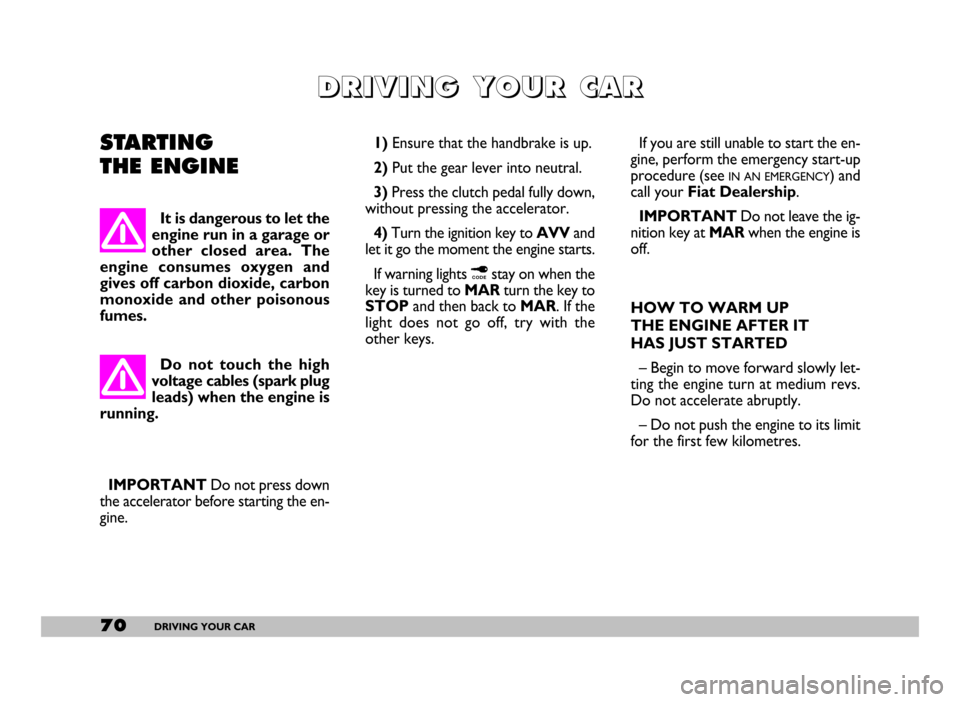
70DRIVING YOUR CAR
STARTING
THE ENGINE1)Ensure that the handbrake is up.
2)Put the gear lever into neutral.
3)Press the clutch pedal fully down,
without pressing the accelerator.
4) Turn the ignition key to AVV and
let it go the moment the engine starts.
If warning lights ¢stay on when the
key is turned to MARturn the key to
STOPand then back to MAR. If the
light does not go off, try with the
other keys.If you are still unable to start the en-
gine, perform the emergency start-up
procedure (see
INANEMERGENCY) and
call your Fiat Dealership.
IMPORTANTDo not leave the ig-
nition key at MARwhen the engine is
off.
HOW TO WARM UP
THE ENGINE AFTER IT
HAS JUST STARTED
– Begin to move forward slowly let-
ting the engine turn at medium revs.
Do not accelerate abruptly.
– Do not push the engine to its limit
for the first few kilometres.
D D D D
R R R R
I I I I
V V V V
I I I I
N N N N
G G G G
Y Y Y Y
O O O O
U U U U
R R R R
C C C C
A A A A
R R R R
It is dangerous to let the
engine run in a garage or
other closed area. The
engine consumes oxygen and
gives off carbon dioxide, carbon
monoxide and other poisonous
fumes.
Do not touch the high
voltage cables (spark plug
leads) when the engine is
running.
IMPORTANT Do not press down
the accelerator before starting the en-
gine.
Page 78 of 154

77DRIVING YOUR CAR
– do not remain stationary in deep
snow with the engine running: the
snow could deviate the exhaust gas
into the passenger compartment.
DRIVING WITH ABS
ABS is a braking system that essen-
tially offers two advantages:
1)it prevents wheel lock-up and
consequent skidding in emergency
stops, particularly when the road does
not offer much grip;
2)it makes it possible to brake and
steer at the same time so you can
avoid unexpected obstacles and direct
the car where you want while braking.
The extent to which this can be done
will depend on the physical limits of
the tyre’s sideways grip.To get the most out of ABS:
– during emergency conditions or
when grip conditions are poor, you
will feel a slight pulsation on the brake
pedal. This is the sign that the ABS is
working. Do not release the brake
pedal but continue to press so as not
to interrupt the braking action;
– ABS prevents the wheels from
locking, but it does not increase actual
grip conditions between tyre and
road. Therefore, even if your car is fit-
ted with ABS, respect the safety dis-
tance from the car in front of you and
keep your speed down when driving
into bends;
– ABS serves to increase the con-
trollability of the car, not to enable
you to go faster.CONTAINING
RUNNING COSTS
AND POLLUTION
Some suggestions which may help
you to keep the running costs of the
vehicle down and lower the amount
of toxic emissions released into the
atmosphere are given below.
GENERAL
CONSIDERATIONS
Car maintenance
The overall state of the car is an im-
portant factor which has a marked in-
fluence over fuel consumption and
driving comfort and on the life span of
your car. For this reason care should
be taken to maintain your car by car-
rying out the necessary checks and
regulations in accordance with the
specifications given in the
SERVICE
SCHEDULE
(see sections: SPARK PLUGS,
IDLING, AIR CLEANERS, TIMING).
Page 81 of 154
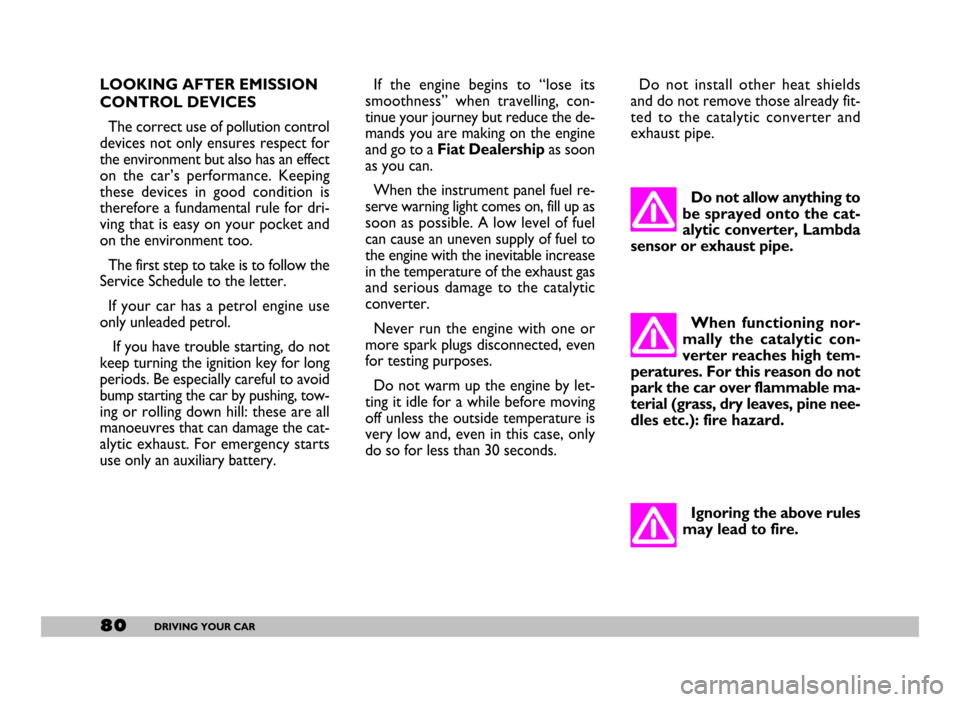
80DRIVING YOUR CAR
LOOKING AFTER EMISSION
CONTROL DEVICES
The correct use of pollution control
devices not only ensures respect for
the environment but also has an effect
on the car’s performance. Keeping
these devices in good condition is
therefore a fundamental rule for dri-
ving that is easy on your pocket and
on the environment too.
The first step to take is to follow the
Service Schedule to the letter.
If your car has a petrol engine use
only unleaded petrol.
If you have trouble starting, do not
keep turning the ignition key for long
periods. Be especially careful to avoid
bump starting the car by pushing, tow-
ing or rolling down hill: these are all
manoeuvres that can damage the cat-
alytic exhaust. For emergency starts
use only an auxiliary battery.If the engine begins to “lose its
smoothness” when travelling, con-
tinue your journey but reduce the de-
mands you are making on the engine
and go to a Fiat Dealershipas soon
as you can.
When the instrument panel fuel re-
serve warning light comes on, fill up as
soon as possible. A low level of fuel
can cause an uneven supply of fuel to
the engine with the inevitable increase
in the temperature of the exhaust gas
and serious damage to the catalytic
converter.
Never run the engine with one or
more spark plugs disconnected, even
for testing purposes.
Do not warm up the engine by let-
ting it idle for a while before moving
off unless the outside temperature is
very low and, even in this case, only
do so for less than 30 seconds.Do not install other heat shields
and do not remove those already fit-
ted to the catalytic converter and
exhaust pipe.
When functioning nor-
mally the catalytic con-
verter reaches high tem-
peratures. For this reason do not
park the car over flammable ma-
terial (grass, dry leaves, pine nee-
dles etc.): fire hazard.
Ignoring the above rules
may lead to fire.
Do not allow anything to
be sprayed onto the cat-
alytic converter, Lambda
sensor or exhaust pipe.
Page 112 of 154

111CAR MAINTENANCE
thousands of kilometres
Check anti-evaporation system
Replace air cleaner cartridge
Top up fluids (engine coolant, brakes, windscreen washer, battery, etc.)
Check timing belt conditions
Replace timing belt (*)
Replace spark plugs
Check engine control systems via diagnostic socket
Check mechanical gearbox oil level
Change engine oil
Replace engine oil filter
Change brake fluid (or every two years) 20 40 60 80 100 120 140 160 180
●●
●●●●
●●●●●●●●●
●●
●
●●●●
●●●●
●●
●●●●●●●●●
●●●●●●●●●
●●●
(*) or every 3 years for demanding use (cold climates, prolonged idling in city traffic)
or every 5 years, regardless of distance
Page 131 of 154
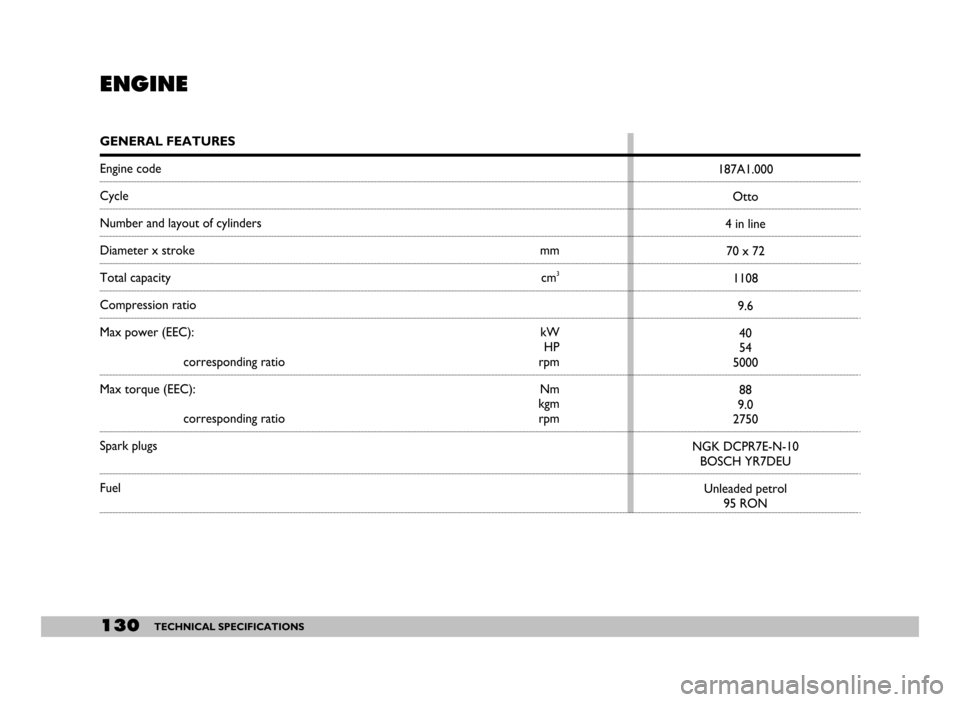
130TECHNICAL SPECIFICATIONS
ENGINE
GENERAL FEATURES
Engine code
Cycle
Number and layout of cylinders
Diameter x stroke mm
Total capacity cm3
Compression ratio
Max power (EEC): kW
HP
corresponding ratio rpm
Max torque (EEC): Nm
kgm
corresponding ratio rpm
Spark plugs
Fuel
187A1.000
Otto
4 in line
70 x 72
1108
9.6
40
54
5000
88
9.0
2750
NGK DCPR7E-N-10
BOSCH YR7DEU
Unleaded petrol
95 RON
Page 132 of 154
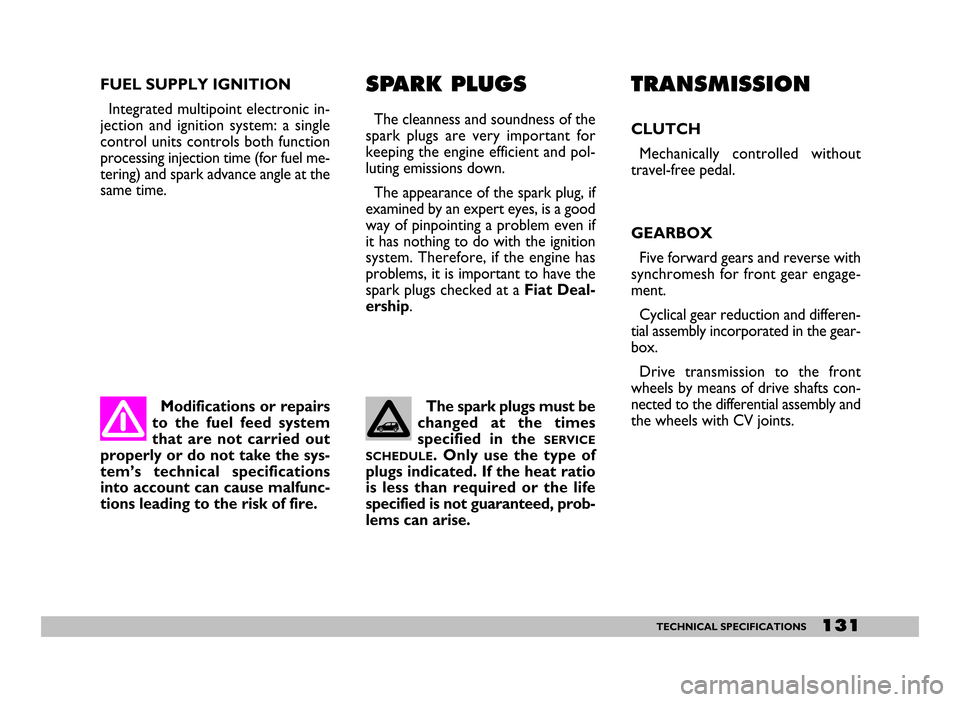
131TECHNICAL SPECIFICATIONS
Modifications or repairs
to the fuel feed system
that are not carried out
properly or do not take the sys-
tem’s technical specifications
into account can cause malfunc-
tions leading to the risk of fire. FUEL SUPPLY IGNITION
Integrated multipoint electronic in-
jection and ignition system: a single
control units controls both function
processing injection time (for fuel me-
tering) and spark advance angle at the
same time.
SPARK PLUGS
The cleanness and soundness of the
spark plugs are very important for
keeping the engine efficient and pol-
luting emissions down.
The appearance of the spark plug, if
examined by an expert eyes, is a good
way of pinpointing a problem even if
it has nothing to do with the ignition
system. Therefore, if the engine has
problems, it is important to have the
spark plugs checked at a Fiat Deal-
ership.
TRANSMISSION
CLUTCH
Mechanically controlled without
travel-free pedal.
GEARBOX
Five forward gears and reverse with
synchromesh for front gear engage-
ment.
Cyclical gear reduction and differen-
tial assembly incorporated in the gear-
box.
Drive transmission to the front
wheels by means of drive shafts con-
nected to the differential assembly and
the wheels with CV joints. The spark plugs must be
changed at the times
specified in the
SERVICE
SCHEDULE
. Only use the type of
plugs indicated. If the heat ratio
is less than required or the life
specified is not guaranteed, prob-
lems can arise.
Page 149 of 154
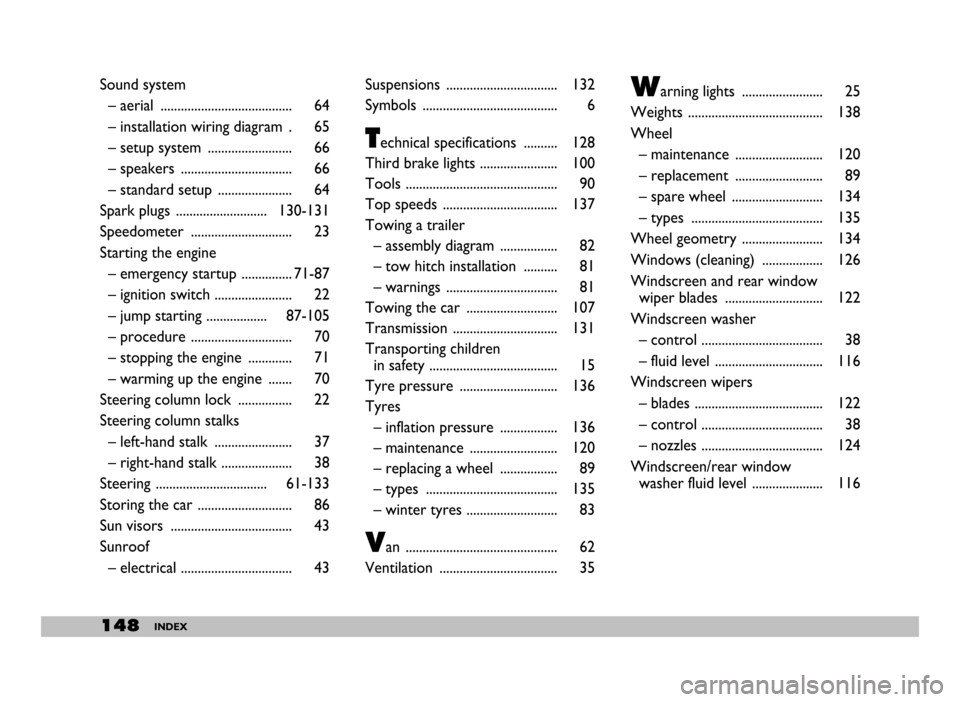
148INDEX
Sound system
– aerial ....................................... 64
– installation wiring diagram . 65
– setup system ......................... 66
– speakers ................................. 66
– standard setup ...................... 64
Spark plugs ........................... 130-131
Speedometer .............................. 23
Starting the engine
– emergency startup ............... 71-87
– ignition switch ....................... 22
– jump starting .................. 87-105
– procedure .............................. 70
– stopping the engine ............. 71
– warming up the engine ....... 70
Steering column lock ................ 22
Steering column stalks
– left-hand stalk ....................... 37
– right-hand stalk ..................... 38
Steering ................................. 61-133
Storing the car ............................ 86
Sun visors .................................... 43
Sunroof
– electrical ................................. 43Suspensions ................................. 132
Symbols ........................................ 6
Technical specifications .......... 128
Third brake lights ....................... 100
Tools ............................................. 90
Top speeds .................................. 137
Towing a trailer
– assembly diagram ................. 82
– tow hitch installation .......... 81
– warnings ................................. 81
Towing the car ........................... 107
Transmission ............................... 131
Transporting children
in safety ...................................... 15
Tyre pressure ............................. 136
Tyres
– inflation pressure ................. 136
– maintenance .......................... 120
– replacing a wheel ................. 89
– types ....................................... 135
– winter tyres ........................... 83
Van ............................................. 62
Ventilation ................................... 35
Warning lights ........................ 25
Weights ........................................ 138
Wheel
– maintenance .......................... 120
– replacement .......................... 89
– spare wheel ........................... 134
– types ....................................... 135
Wheel geometry ........................ 134
Windows (cleaning) .................. 126
Windscreen and rear window
wiper blades ............................. 122
Windscreen washer
– control .................................... 38
– fluid level ................................ 116
Windscreen wipers
– blades ...................................... 122
– control .................................... 38
– nozzles .................................... 124
Windscreen/rear window
washer fluid level ..................... 116